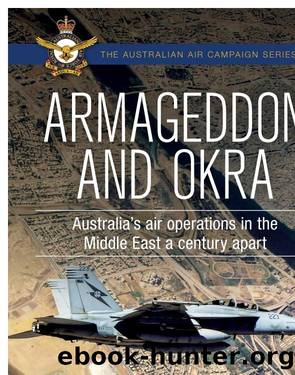Armageddon and OKRA by Lewis Frederickson

Author:Lewis Frederickson
Language: eng
Format: epub
ISBN: 9781922387554
Publisher: Big Sky Publishing
RAAF Command and Control
Just how an Australian Air Task Group would fit into this organisation was significant. As Australiaâs contribution was relatively small, its assets would require careful management to realise their potential. Given the nature of the environment, there were always going to be challenges associated with establishing the command and control mechanism for the Air Task Group. More than a decade earlier, Prime Minister John Howard had pledged immediate support to the United States in the aftermath of the 11 September 2001 attacks. The reaffirmation of the commitment to a âwar on terrorismâ by successive governments served to not only underwrite the Australian-US alliance, but also resulted in the ADF already having a sizeable presence in the region when the Air Task Group arrived. ATG630âs command and control arrangements were thus predicated on the nature of Australian operations in the Middle East Region as they had been throughout the preceding decade. Notwithstanding this, there would be ongoing differences of opinion over the command arrangements that were never quite resolved during the course of the operation.
An Australian theatre headquarters commanded by a two-star Joint Force Commander had deployed very shortly after the Australian Governmentâs decision in 2003 to commit forces to operations in Iraq. Joint Task Force 633 (JTF633) served as the Headquarters for Australian forces in the Middle East Region and was initially established in one of Saddam Husseinâs former palaces in Camp Victory adjacent to Baghdad International Airportâit came to be called âAustralia Houseâ. The Headquarters had wide responsibilities. Headquarters JTF633 exercised National Command over a force of assigned elements from each of the Services. This arrangement was in place to ensure that Australian assets were always to be used in accordance with the Australian Governmentâs direction and objectives. By 2007, Australian forces were serving across all domains in support of operations in the Persian Gulf, Indian Ocean, Iraq, Kuwait, Qatar and Afghanistan. The geographical distances and regional disparity were significant. It was about a thousand miles from the middle of the Persian Gulf to Kabul in Afghanistan, and a similar distance from the southern Gulf to the northern reaches of Iraq. Just as Iraq presented its own internal environmental challenges, the huge expanse of the wider theatre of operations posed many problems for planners and logisticians.
As Australian operations in Iraq drew down in late 2008, Headquarters JTF633 was relocated from Camp Victory to Al Minhad Air Base, near Dubai in the United Arab Emirates. Al Minhad had formerly been used by ADF elements during the invasion of Iraq in Gulf War II and then remained as a base for RAAF AP-3C surveillance aircraft. The consolidation to this one location also resulted in RAAF C130 air mobility operations relocating from Al Udeid in Qatar, and the logistics hub and Reception, Staging, Onwards-clearance and Insertion (RSO&I) facilities moving south from Ali Al Salim air base in Kuwait. RSO&I provides the final preparation for personnel before they move forward to their deployed locations, while at the same time providing acclimatisation to the new environment.
Download
This site does not store any files on its server. We only index and link to content provided by other sites. Please contact the content providers to delete copyright contents if any and email us, we'll remove relevant links or contents immediately.
| Africa | Americas |
| Arctic & Antarctica | Asia |
| Australia & Oceania | Europe |
| Middle East | Russia |
| United States | World |
| Ancient Civilizations | Military |
| Historical Study & Educational Resources |
The Bomber Mafia by Malcolm Gladwell(1184)
Submerged Prehistory by Benjamin Jonathan; & Clive Bonsall & Catriona Pickard & Anders Fischer(1162)
Facing the Mountain by Daniel James Brown(1136)
The Dawn of Everything by David Graeber & David Wengrow(1112)
The Way of Fire and Ice: The Living Tradition of Norse Paganism by Ryan Smith(1033)
Wandering in Strange Lands by Morgan Jerkins(1019)
Tip Top by Bill James(1004)
Driving While Brown: Sheriff Joe Arpaio Versus the Latino Resistance by Terry Greene Sterling & Jude Joffe-Block(1003)
Evil Geniuses: The Unmaking of America: A Recent History by Kurt Andersen(1001)
Red Roulette : An Insider's Story of Wealth, Power, Corruption, and Vengeance in Today's China (9781982156176) by Shum Desmond(1000)
F*cking History by The Captain(969)
It Was All a Lie by Stuart Stevens;(943)
White House Inc. by Dan Alexander(908)
Evil Geniuses by Kurt Andersen(903)
Treasure Islands: Tax Havens and the Men who Stole the World by Nicholas Shaxson(881)
American Dreams by Unknown(860)
American Kompromat by Craig Unger(850)
The Fifteen Biggest Lies about the Economy: And Everything Else the Right Doesn't Want You to Know about Taxes, Jobs, and Corporate America by Joshua Holland(817)
The First Conspiracy by Brad Meltzer & Josh Mensch(813)
